John George’s Planes
Bonanza V35
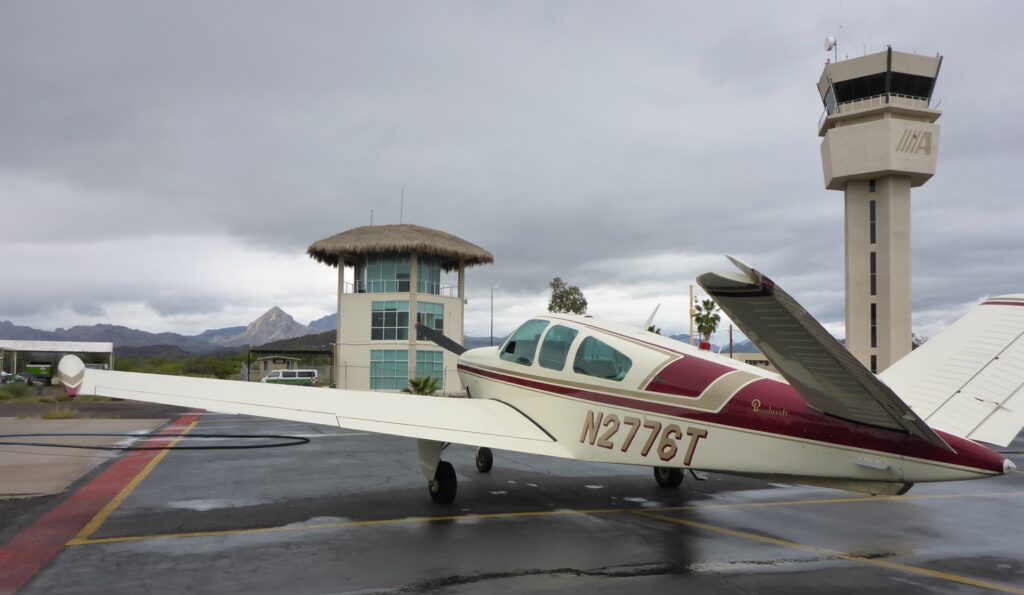
N2776T is a 1967 Beechcraft Bonanza V35. It began life with a normally aspirated engine, but in the early 1980s it was converted to turbocharged operation using the same STC employed by the Beech factory to produce the V35TC. This is helpful at high mountain airports in the summer, with density altitudes often in the low 5 figures.
It is a “going places” airplane, with a top speed of well over 200 mph, typically flown lean of peak, with a fuel burn of 13 gph at an airspeed of 165 kts (~190mph) at 10,000 ft. Tip tanks extend the fuel capacity to 104 gallons, approaching 8 hours of endurance and generally outlasting the pilot. This allows me to reach the west coast, points east of the Mississippi, or Loreto on the Sea of Cortez in Baja, Mexico (shown above) in a single hop.

Since acquiring the aircraft in 2007, I have undertaken a series of upgrades including an engine baffle kit, a new primary and a backup alternator, and have replaced the exhaust system, gear motor and fuel boost pumps. The panel has also received attention: in addition to a WAAS upgrade to an existing Garmin 530 navcom/GPS Navigator, a JPI 900 graphic engine monitor, a Garmin communications panel, and ADS-B were added. An Aspen Evolution PFD providing all IFR instruments replaced two of the original “steam gauges”. The carpet and the windscreen and windows have been replaced, and the seats reupholstered. Further cosmetic upgrades to the interior are planned.
Vertical Flight
My interest in Short Take-Off and Landing (STOL) aircraft and vertical flight was driven by my desire to fly off a small (~3 acre) pasture next to our home in Abiquiu. It was clear that none of the fixed wing aircraft that I had ever flown offered the performance required to achieve that objective.
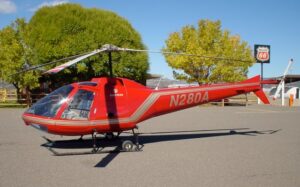
As a first step toward that goal I entered into a partnership with Paul Lisowski of Los Alamos, and Dave Johnson of Edgewood, to purchase and operate an Enstrom 280C helicopter. A helicopter is capable of amazing things, and is thrilling to fly, but it is also challenging and demanding. Hovering operations require extremely subtle control inputs, but an emergency such as engine failure requires split-second, decisive response to avoid a catastrophic rotor stall. Training requirements are extensive and expensive, as are costs of acquiring, insuring, and maintaining the aircraft. Though the Enstrom engine was turbocharged, it worked hard on high and hot summer days in NM. Eventually, after an emergency autorotation to landing (thankfully not as PIC), and paying another large repair bill, I decided that absent a commercial application, it was difficult to justify the use of a certified helicopter as a personal aircraft.
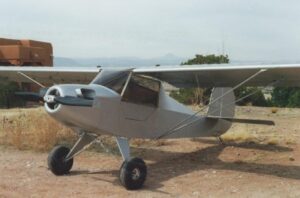
During that time, I also began exploring options for STOL fixed wing aircraft. Long used for niche applications such as bush flying, these aircraft have recently emerged as a fast-growing segment of aviation for recreation and competition. By chance I found a small single seater called a SkyRaider, (a descendant of early Avid Flyers and Kit Fox solo aircraft) reputed to have good STOL performance. Since it was marketed as a Part 103 ultralight it was not registered, and a brief FAA window for transitioning such non-conforming “fat ultralights” to LSA status had long since passed, but with perseverance I was able to get it registered as an amateur built experimental. It awaits DAR inspection to gain Airworthiness Certification.
Over the course of flying the helicopter, I became increasingly interested in gyroplanes, also known as autogyros or gyrocopters. These rotorcraft, the predecessors of helicopters, were developed in the early 1920s in an attempt to eliminate stall-spin accidents that ended the careers of many pioneering pilots. The gyroplane flies in autorotation, so that the loss of an engine poses no more challenge than in a fixed wing airplane… perhaps less so, since a gyroplane can handle a steeper descent and land in the space of a tennis court. The Popular Rotorcraft Association notes that ” the gyroplane provides 90% of the capability of a helicopter at 10% of the cost”, although as gyros have become more sophisticated that cost differential has shrunk. An old pilot from Socorro, who had flown almost everything over the course of his career, told me that a gyroplane was the most fun he’d had flying.
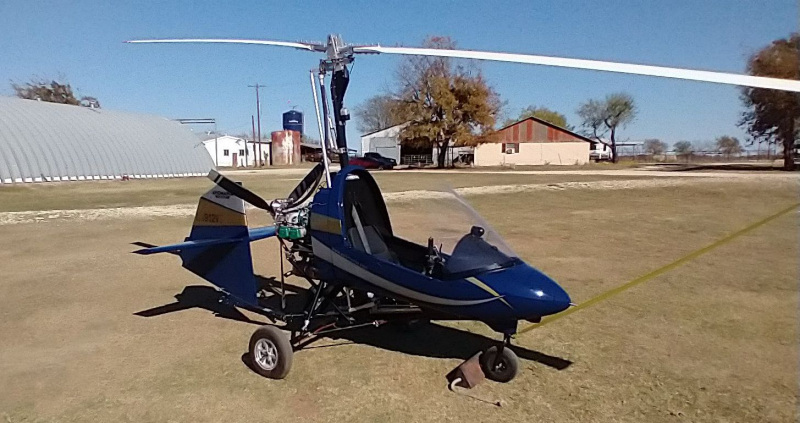
I resolved to acquire and learn to fly a gyroplane. Effectively, this meant building the aircraft, since all gyroplanes available at the time in the US market were amateur-built experimental kits. In the intervening years, several models by the German firm Autgyro AG have completed certification. I settled on a kit by Aviomania, for a high-performance, single-place gyroplane (G1sE) based on its safety features, attractive design and pricing and “convertible” design allowing it to operate as an open or enclosed “all season” aircraft. I estimate around 500 hours spent on the project, most of the time spent developing enhanced systems not provided by the kit. The assembly of the basic kit can be completed in 2-4 weeks by a knowledgeable and motivated builder.
Gyroplanes are still fairly rare in the US, though their numbers are growing. Training is typically in a two-place trainer (tandem or side by side) and is often undertaken with a dealer or builder assistance program. Outside of such programs, training may be hard to find, and transition training for a single place, harder still. On the positive side, for a licensed private or recreational pilot, the add-on rating requires only demonstration of proficiency to a CFI other than the one providing primary training. Proficient operation may be achieved in 10 hours or even less, but 20 hours of training or more seem reasonable given the significant differences from fixed-wing operations.
Unlike helicopters, conventional gyroplanes are not designed for vertical takeoff, landing (VTOL) and hovering. Gyroplanes often use ground runs of 1000 ft or more to achieve adequate rotor speed for takeoff. Based on performance specifications I estimate that the Aviomania G1sE can achieve a high-performance rolling takeoff in 200 to 400 ft, depending on conditions and the skill of the pilot. This would allow operation from my field, albeit without much margin.
Although “jump takeoff” gyroplanes were demonstrated early on, these provide a very different (ballistic) experience than the gentle, controlled liftoff that can be achieved in a helicopter. The application of power to the main rotor while in flight introduces torque that tends to spin the fuselage, and conventional methods used to compensate for this problem in the helicopter (including an engine-driven tail rotor) are not readily applicable for a gyroplane.
In the course of thinking about and ultimately building my gyroplane, I developed ideas for a VTOL gyroplane, using an electric motor to transiently power the main rotor, and a coaxial, counter-rotating (CACR) main rotor or electrically driven tail rotor for torque compensation. These ideas led to a US patent, issued in September of 2022. I am pursuing plans for development of prototypes embodying each of these systems, using the Aviomania as the platform.
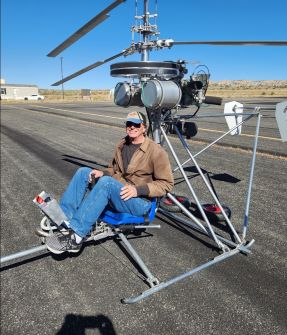
In order to get experience with a working CACR system, I recently acquired a Mirocopter SCH-2A, an ultralight helicopter that is one of the very few commercially available light helicopters incorporating this design. I am practicing in a Robinson R22 in preparation for first liftoff.
